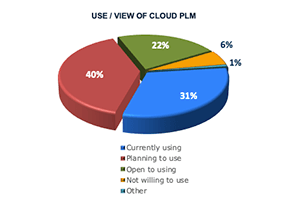 Companies are making a significant shift to the cloud, how is that impacting PLM? What do manufacturers need to be aware of related to features, customization, and upgrades as they make the transition? Our survey results include insights from over one hundred manufacturers to find out.
Companies are making a significant shift to the cloud, how is that impacting PLM? What do manufacturers need to be aware of related to features, customization, and upgrades as they make the transition? Our survey results include insights from over one hundred manufacturers to find out.
Please enjoy the summary below.* For the full report, please visit our sponsor Aras (registration required).
For related content, watch the interactive webinar replay where Jim Brown shares in-depth insights from his conversations with customers.
Table of Contents
- PLM is Moving to the Cloud
- Cloud Transformation Patience is Over
- Current State of PLM Boosts Cloud Opportunity
- Take an Objective Look at Customization
- Plan for the Reality of Customization
- Understand Upgrade Processes
- Ensure PLM Delivers Business Value
- Conclusions
- About the Research
- Acknowledgments
Cloud PLM Adoption Accelerating
Develop Cloud Transition Strategy
Companies are making a significant shift to cloud software. To get a clearer picture of the manufacturing industry’s current state and future plans for cloud PLM, Tech-Clarity surveyed over one hundred larger manufacturers with over 500 employees. Survey results show that cloud PLM adoption is accelerating and becoming the norm.
Understand Implications
Manufacturers favor cloud solutions and the majority now use, or plan to use, cloud PLM. Although most companies are familiar with the benefits of the cloud, not all companies understand the implications of cloud deployment model and architecture choices. In particular, this survey examines several important considerations for ensuring they drive business value from their PLM implementation, including the impacts on:
- Features needed to reach business goals
- Customization to achieve business value and ensure user adoption
- Upgrade timing to access innovation while remaining compliant
PLM is Moving to the Cloud
 Manufacturers Now Favor the Cloud
Manufacturers Now Favor the Cloud
The shift to cloud software is a relatively recent, fundamental shift in IT architecture. Only 17% of companies participating in our 2018 study1 had a software strategy that called for only using the cloud, using the cloud unless no capable solution was available, or preferring the cloud. Instead, over one-third would choose the most capable solution and about one-quarter did not consider or allow the cloud.
The 2022 survey reflects a dramatically different climate. Now, about three-quarters of companies favor, prefer, or mandate the cloud for their new software selections. In fact, only 4% of responding companies say they do not consider or allow the cloud.
PLM Cloud Transformation has Accelerated
Those results detail companies’ overall cloud strategy, but how does that relate to PLM? PLM adoption has traditionally lagged behind other enterprise software solutions. While some attributed lower adoption to security concerns, we believe it was because companies were forced to choose between cloud solutions or fully-featured PLM. Either way, it’s clear that the PLM transformation is now picking up pace. Almost three-quarters of surveyed companies are either using cloud PLM or to planning to do so. Very few, on the other hand, are unwilling to use the cloud. Our experience shows that this is likely due to regulatory or customer mandates.
Conclusions
 The Transition is Underway
The Transition is Underway
A fundamental cloud PLM transition is underway and has accelerated. Despite a slower start than some other applications like ERP or CRM, manufacturers are rapidly pursuing cloud PLM solutions. Cloud PLM offers significant benefits, and companies appear to have transitioned from deciding “if” to implement a cloud solution for PLM and now are discussing “when” and “how.”
Cloud Transformation Offers Additional Improvement Opportunities
In addition to cloud benefits, the large number of companies planning to replace their PLM system with a cloud offering can benefit from a “reset” if their PLM system does not move to the cloud quickly enough. This reset may be valuable because the common state of PLM hampers progress and value due to:
- Outdated PLM systems that have not been recently upgraded, resulting in missed opportunity to take advantage of functional and technical enhancement opportunities. Our experience shows this is frequently due to dead-end customization approaches that make upgrades extremely challenging.
- Multiple PLM systems, leading to high cost and operational disadvantages that limit PLM value.
Companies Must Consider PLM Approach and Architecture to Ensure Value
Cloud is compelling but key architecture and solution decisions impact the value companies can achieve. Manufacturers need to carefully consider their chosen cloud PLM for its impact on:
- The need and ability to customize PLM
- The requirements and limitations related to controlling PLM upgrade timing
- The ability to deliver the rich PLM capabilities they need to deliver value
*This summary is an abbreviated version of the research and does not contain the full content. For the full research, please visit our sponsor Aras (registration required).
If you have difficulty obtaining a copy of the report, please contact us.

